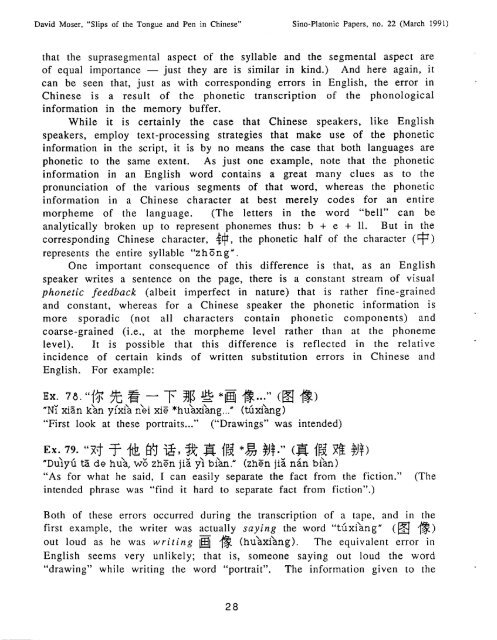Slips of the Tongue and Pen in Chinese - Sino-Platonic Papers
Slips of the Tongue and Pen in Chinese - Sino-Platonic Papers
Slips of the Tongue and Pen in Chinese - Sino-Platonic Papers
You also want an ePaper? Increase the reach of your titles
YUMPU automatically turns print PDFs into web optimized ePapers that Google loves.
David Moser, "<strong>Slips</strong> <strong>of</strong> <strong>the</strong> <strong>Tongue</strong> <strong>and</strong> <strong>Pen</strong> <strong>in</strong> Ch<strong>in</strong>ese" S<strong>in</strong>o-<strong>Platonic</strong> <strong>Papers</strong>, no. 22 (March 199 1)<br />
that <strong>the</strong> suprasegmental aspect <strong>of</strong> <strong>the</strong> syllable <strong>and</strong> <strong>the</strong> segmental aspect are<br />
<strong>of</strong> equal importance - just <strong>the</strong>y are is similar <strong>in</strong> k<strong>in</strong>d.) And here aga<strong>in</strong>, it<br />
can be seen that, just as with correspond<strong>in</strong>g errors <strong>in</strong> English, <strong>the</strong> error <strong>in</strong><br />
Ch<strong>in</strong>ese is a result <strong>of</strong> <strong>the</strong> phonetic transcription <strong>of</strong> <strong>the</strong> phonological<br />
<strong>in</strong>formation <strong>in</strong> <strong>the</strong> memory buffer.<br />
While it is certa<strong>in</strong>ly <strong>the</strong> case that Ch<strong>in</strong>ese speakers, like English<br />
speakers, employ text-process<strong>in</strong>g strategies that make use <strong>of</strong> <strong>the</strong> phonetic<br />
<strong>in</strong>formation <strong>in</strong> <strong>the</strong> script, it is by no means <strong>the</strong> case that both languages are<br />
phonetic to <strong>the</strong> same extent. As just one example, note that <strong>the</strong> phonetic<br />
<strong>in</strong>formation <strong>in</strong> an English word conta<strong>in</strong>s a great many clues as to <strong>the</strong><br />
pronunciation <strong>of</strong> <strong>the</strong> various segments <strong>of</strong> that word, whereas <strong>the</strong> phonetic<br />
<strong>in</strong>formation <strong>in</strong> a Ch<strong>in</strong>ese character at best merely codes for an entire<br />
morpheme <strong>of</strong> <strong>the</strong> language. (The letters <strong>in</strong> <strong>the</strong> word "bell" can be<br />
analytically broken up to represent phonemes thus: b + e + 11. But <strong>in</strong> <strong>the</strong><br />
correspond<strong>in</strong>g Ch<strong>in</strong>ese character, #$, <strong>the</strong> phonetic half <strong>of</strong> <strong>the</strong> character (p)<br />
represents <strong>the</strong> entire syllable "Z h 5 n g ' .<br />
One important consequence <strong>of</strong> this difference is that, as an English<br />
speaker writes a sentence on <strong>the</strong> page, <strong>the</strong>re is a constant stream <strong>of</strong> visual<br />
phonetic feedback (albeit imperfect <strong>in</strong> nature) that is ra<strong>the</strong>r f<strong>in</strong>e-gra<strong>in</strong>ed<br />
<strong>and</strong> constant, whereas for a Ch<strong>in</strong>ese speaker <strong>the</strong> phonetic <strong>in</strong>formation is<br />
more sporadic (not all characters conta<strong>in</strong> phonetic components) <strong>and</strong><br />
coarse-gra<strong>in</strong>ed (i.., at <strong>the</strong> morpheme level ra<strong>the</strong>r than at <strong>the</strong> phoneme<br />
level). It is possible that this difference is reflected <strong>in</strong> <strong>the</strong> relative<br />
<strong>in</strong>cidence <strong>of</strong> certa<strong>in</strong> k<strong>in</strong>ds <strong>of</strong> written substitution errors <strong>in</strong> Ch<strong>in</strong>ese <strong>and</strong><br />
English. For example:<br />
"First look at <strong>the</strong>se portraits ..." ("Draw<strong>in</strong>gs" was <strong>in</strong>tended)<br />
"As for what he said, I can easily separate <strong>the</strong> fact from <strong>the</strong> fiction." (The<br />
<strong>in</strong>tended phrase was "f<strong>in</strong>d it hard to separate fact from fiction".)<br />
Both <strong>of</strong> <strong>the</strong>se errors occurred dur<strong>in</strong>g <strong>the</strong> transcription <strong>of</strong> a tape, <strong>and</strong> <strong>in</strong> <strong>the</strong><br />
first example, <strong>the</strong> writer was actually say<strong>in</strong>g <strong>the</strong> word ''tGxi\angM (E f$)<br />
out loud as he was writ<strong>in</strong>g @ f$ (hu'axi'ang). The equivalent error <strong>in</strong><br />
English seems very unlikely; that is, someone say<strong>in</strong>g out loud <strong>the</strong> word<br />
"draw<strong>in</strong>g" while writ<strong>in</strong>g <strong>the</strong> word "portrait". The <strong>in</strong>formation given to <strong>the</strong>
















